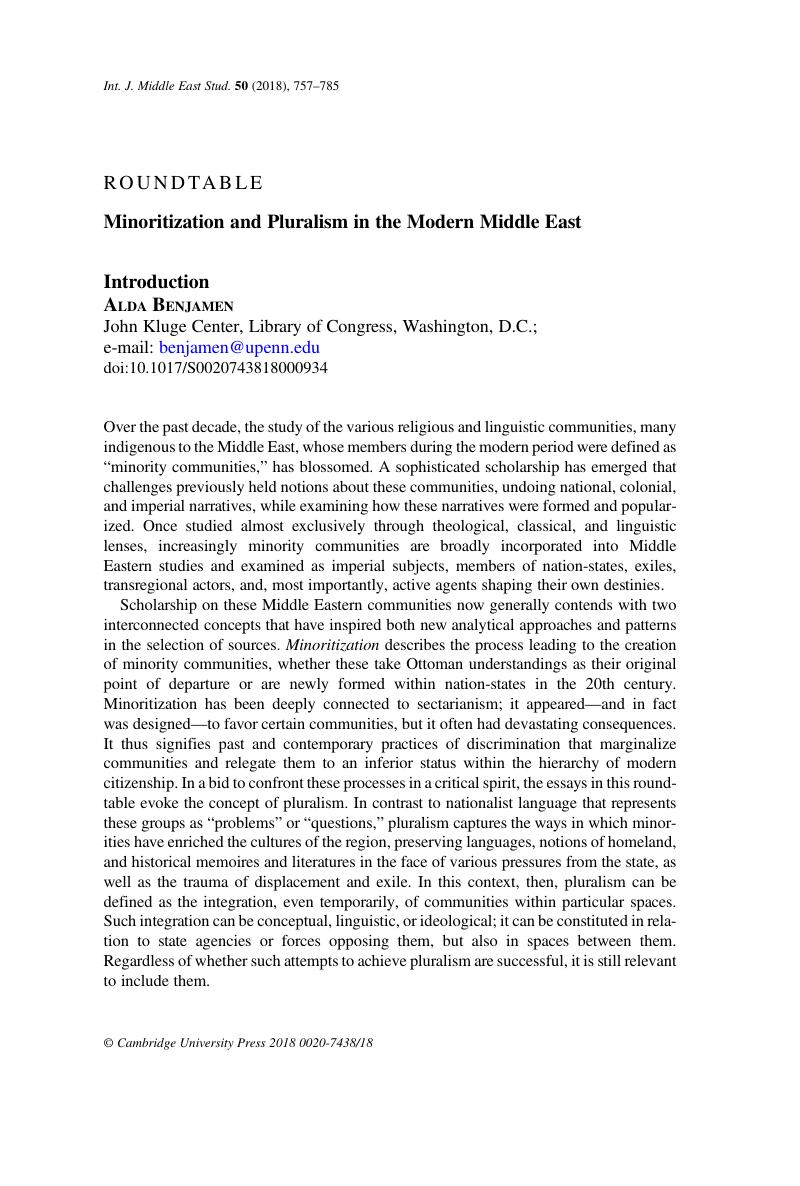Article contents
Introduction
Published online by Cambridge University Press: 28 November 2018
Abstract

- Type
- Roundtable
- Information
- Copyright
- Copyright © Cambridge University Press 2018
References
NOTES
1 See Bashkin, Orit, The Other Iraq: Pluralism and Culture in Hashemite Iraq (Stanford, Calif.: Stanford University Press, 2009)Google Scholar; Bashkin, , New Babylonians: A History of Jews in Modern Iraq (Stanford, Calif.: Stanford University Press, 2012)Google Scholar; Ibrahim, Vivian, The Copts of Egypt: Challenges of Modernisation and Identity (New York: Tauris Academic Studies, 2011)Google Scholar; and Sharkey, Heather J., A History of Muslims, Christians, and Jews in the Middle East (Cambridge: Cambridge University Press, 2017)CrossRefGoogle Scholar.
2 On transnational Christian Media, see Armanios, Febe and Amstutz, Andrew, “Emerging Christian Media in Egypt: Clerical Authority and the Visualization of Women in Coptic Video Films,” International Journal of Middle East Studies 45 (2013): 513–33CrossRefGoogle Scholar; and Febe Armanios's forthcoming book on Christian television. On Diasporic minority communities, see Khater, Akram Fouad, Inventing Home: Emigration, Gender, and the Middle Class in Lebanon, 1870–1920 (Berkeley, Calif.: University of California Press, 2001)Google Scholar; and Yasmeen Hanoosh, “The Politics of Minority: Chaldeans between Iraq and America” (PhD diss., University of Michigan, 2008). On the provincial history of northern Iraq, see Shlimon, Arbella Bet, City of Black Gold: Oil, Ethnicity, and the Making of Modern Kirkuk (Stanford, Calif.: Stanford University Press, 2019)Google Scholar.
3 On Armenian citizens of Turkey after the genocide, see Ekmekçioğlu, Lerna, Recovering Armenia: The Limits of Belonging in Post-Genocide Turkey (Stanford, Calif.: Stanford University Press, 2016)Google Scholar. On Palestinian citizens of Israel and decolonization, see Nassar, Maha, Brothers Apart: Palestinian Citizens of Israel and the Arab World (Stanford, Calif., Stanford University Press, 2017)Google Scholar. On race and indigeneity in Iraq, see Mariam Georgis, “Postwar Iraq (2003–2016): A Postcolonial, Grassroots Approach to the Failure of ‘Democratic Nation Building’” (PhD diss., University of Alberta, 2017).
4 Makdisi, Ussama, The Culture of Sectarianism: Community, History, and Violence in Nineteenth-Century Ottoman Lebanon (Berkeley, Calif.: University of California Press, 2000)Google Scholar; Haddad, Fanar, Sectarianism in Iraq: Antagonistic Visions of Unity (London: Hurst, 2011)Google Scholar.
- 1
- Cited by


